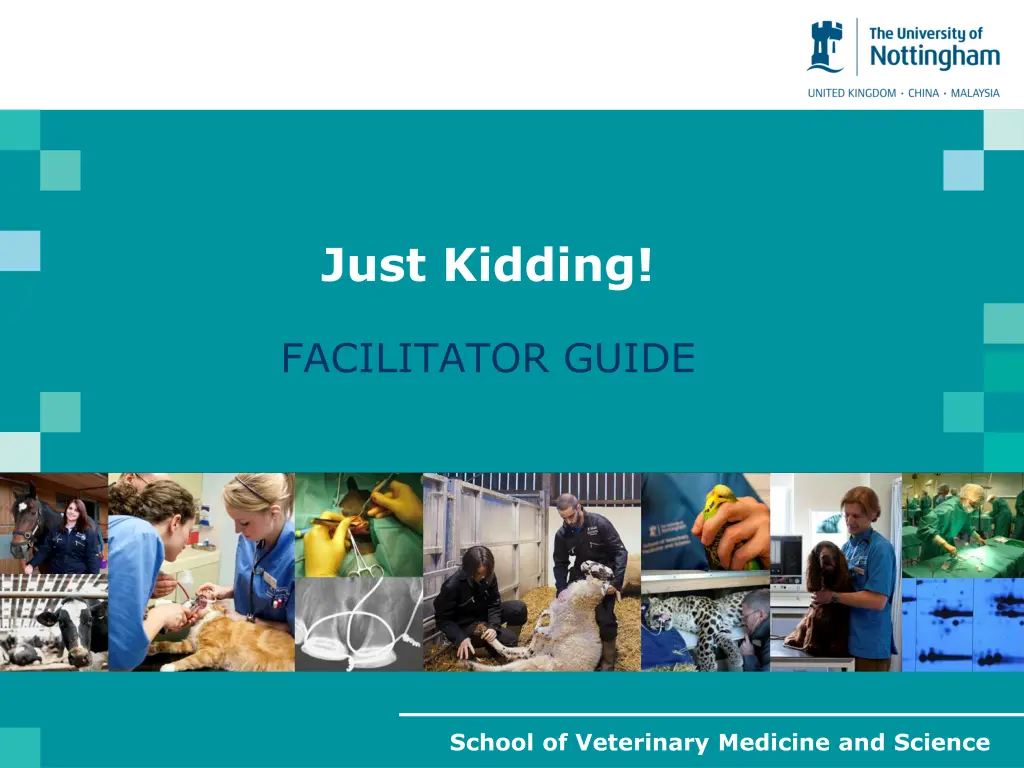
Veterinary Medicine and Science: Case Study on Pseudopregnancy in Goats
Explore a case study on pseudopregnancy in goats, detailing the extended luteal phase, diagnosis methods, clinical impacts, treatment options, and client communication skills. This educational material covers a range of species and addresses key biological and husbandry issues in reproductive cases.
Download Presentation

Please find below an Image/Link to download the presentation.
The content on the website is provided AS IS for your information and personal use only. It may not be sold, licensed, or shared on other websites without obtaining consent from the author. If you encounter any issues during the download, it is possible that the publisher has removed the file from their server.
You are allowed to download the files provided on this website for personal or commercial use, subject to the condition that they are used lawfully. All files are the property of their respective owners.
The content on the website is provided AS IS for your information and personal use only. It may not be sold, licensed, or shared on other websites without obtaining consent from the author.
E N D
Presentation Transcript
Just Kidding! FACILITATOR GUIDE School of Veterinary Medicine and Science
Generic Learning Objectives (common to all cases in Reproduction 1 module) Session 1 DGL To discuss key biological and husbandry issues required to progress the case. Session 2 DGL Acquisition of knowledge relating broadly to the case through completion and discussion of tasks. Discuss further biological and clinical issues and concepts that underpin the case. Session 3 Clinical Relevance To recognise diagnostic tests and their biological basis. Debating biological principles that underpin a clinical case. Recognising the wider issues of clinical case management. School of Veterinary Medicine and Science
Case Learning Objectives Describe the reasons for prolongation of the luteal phase in the goat. Define and describe the concept and incidence of pseudopregnancy across species. Explain the methods employed to detect pseudopregnancy. Describe the clinical consequences of pseudopregnancy in the goat, dog, mare, queen, sow and dolphin. Describe the principles of the treatment options for pseudopregnancy across species. School of Veterinary Medicine and Science
Background information for facilitators The case comprises 12 pregnant does from a 120 goat herd (diagnosed pregnant in early pregnancy) that are past their expected date of delivery. The does appear to be pregnant in terms of abdominal distension and mammary gland development and other does in the herd have delivered on time and kidded normally indicative of a non-infection based aetiology. Ultimately, ultrasound scanning of the does reveals that there is no foetal tissue present and that the uterus is full of fluid; a condition known as cloudburst (pseudopregnancy). Blood samples, taken at the time of scanning revealed that progesterone levels were elevated, but slightly lower than in a normal pregnancy. Oestrone sulfate levels were negligable confirming pseudopregnancy. The case explores the biological mechanism by which the corpus luteum is maintained in pregnancy and how the luteal phase may be prolonged in the absence of a foetus. The causes, incidence and management of pseudopregnancy are investigated across species. The case concludes with consideration of some of the possible risk factors involved and the communication skills required to explain the outcome of the investigation to the client. School of Veterinary Medicine and Science
Student Instructions (Monday DGL) 1. Read the history of this case and identify any terms that you do not understand. 2. Within your group answer and discuss the questions set on the case. Questions have been set on (a) the underlying biology of the case and (b) the husbandry/ clinical component of the case. School of Veterinary Medicine and Science
Just Kidding! Case presentation Owner Name Species Breed Hill Goat Saanan Cross Age Gender Colour Weight (kgs) Female Entire White 72 BCS Height Other School of Veterinary Medicine and Science
Current medical history: Mr Hill calls you to investigate 12 pregnant does that are past their calculated due date. Your distant clinical examination indicates that the does are bright and alert, with ventral abdominal distension suggesting that they were still pregnant. A physical examination of several of the does confirms your initial observation, and in addition, palpation of the udder indicates that normal pre-parturient mammary gland development is occurring. Past medical history: Mr Hill purchased an existing 120 goat herd in mid-December and was told by the vendor that a majority of the does were pregnant. In February, he decided to have them checked for pregnancy and contacted you as his veterinary surgeon. Having recently qualified, the visit to Mr Hills farm was only your second professional visit since joining a local practice and on arrival at the farm you scan the does with your handy-dandy mobile ultrasound machine. You conclude that 80 of the does were pregnant and that all of the pregnancies appear normal. School of Veterinary Medicine and Science
Biological questions What hormonal changes occur in late pregnancy and prior to parturition in the doe? Where are these hormones produced? What are the possible endocrine reasons for a delay in parturition? What factors might be measured in blood samples taken from these does? School of Veterinary Medicine and Science
Notes and definitions for facilitators Hormonal changes in late pregnancy in the doe goat: In this species the CLs produce all of the progesterone. The rise in fetal cortisol stimulates placental 17 alpha hydroxylase and other enzymes which convert progesterone to oestradiol. The change in ratio stimulates PGF2alpha synthesis which causes luteolysis and a decline in progesterone. Delayed parturition: may be due to a lack of fetal tissue, a lack of fetal cortisol (the fetal signal for parturition) e.g., delay in fetal maturation. There are a range of causes for dystocia manifest by delayed parturition. These may be maternal or fetal in origin e.g., fetomaternal disproportion, fetal disposition and uterine inertia. Key factors to measure: in these does, oestrone sulfate (see defintion) and progesterone. Cloudburst: the natural termination of pseudopregnancy in goats characterised by a discharge of large volumes of fluid. Hydrometra is the clinical term for fluid build up in the uterus. Oestrone sulfate: major metabolite of oestradiol and oestrone. Although oestrogens are produced from the ovaries and the placenta, oestrone sulfate is thought to be a product of steroid conjugation by foetal and placental tissue. Consequently it is 100% accurate in pregnancy diagnosis at 40 to 50 days gestation. A threshold value of 1 ng/ml has been reported to differentiate between pregnant and non-pregnant goats. Plasma levels increase to 4 to 5 ng/ml in singleton pregnancies and to approximately 7.0 ng/ml in twin pregnancies. School of Veterinary Medicine and Science
Clinical Husbandry questions When do goats come into season and when should they be bred? What information do you need to progress the case? Think about what factors may be associated with prolonged pregnancy or pseudopregnancy. School of Veterinary Medicine and Science
Information for facilitators Breeding season: Sept to Dec. Information to progress the case Were the goats treated with any pharmacological agents to induce heat? How are the does currently housed? What diet have the does been on prior to and after purchase? What is the source of drinking water? What is the vaccination status of the herd? Are there any disease problems in individuals or groups of does? School of Veterinary Medicine and Science
Student Instructions: Case 1 (Wed DGL) 1. Complete the following tasks and answer the set questions. 2. Generate a list of take home messages arising from completion of the tasks. School of Veterinary Medicine and Science
Description of DGL tasks There are two tasks to complete in this session. The first task investigates progesterone production throughout gestation in a variety of species. The second focuses on pseudopregnancy across species. Complete the 2 tables presented. Consider the information in the tables and generate a list of take home messages School of Veterinary Medicine and Science
Task 1 Task 1: The main source of progesterone during pregnancy may change depending on species and/or the luteo-placental shift. Define what is meant by this expression and complete the table below in relation to the following species. Species Luteo-placental shift +/- Period of gestation Goat Dog 140-210 days Local concns important, Systemic levels low Mare Yes Sheep Yes 50 days Sow No n/a Human Yes 60-70 days Cow School of Veterinary Medicine and Science
Task 2: Complete the table indicating the incidence, possible causes and clinical management of pseudopregnancy in the following species: Assoc with preg loss No Clinical management Species Incidence Likely causes Goat Yes Dog No Yes Mare Yes Ovulation without fertilisation Pregnancy loss after fertilisation Failure of CL regression 20% of queens have 1 episode per year of spontaneous ovulation No Non required Queen Yes Non required Variable and mainly associated with infectious disease No Sow Yes Either failure of CL regression or preg loss Dolphin Unknown Both observed Presumably PG admin School of Veterinary Medicine and Science
Task 1 Task 1: The main source of progesterone during pregnancy may change depending on species and/or the luteo-placental shift. Define what is meant by this expression and complete the table below in relation to the following species. Species Luteo-placental shift +/- Period of gestation Goat No n/a Dog No n/a 140-210 days Local concns important, Systemic levels low Mare Yes Sheep Yes 50 days Sow No n/a Human Yes 60-70 days Cow Yes 200 days School of Veterinary Medicine and Science
Task 2: Complete the table indicating the incidence, possible causes and clinical management of pseudopregnancy in the following species: Assoc with preg loss Clinical management Species Incidence Likely causes Failure of CL regression Preg loss & failure of CL regression No Admin of PG Variable: Goat 2 20% of goats per year Yes Admin of PG Not required but clinical signs can be treated with prolactin inhibitors All non-preg bitches but with variable clinical signs Normal non-preg luteal phase similar to pregnant lut phase Dog No Type I Preg loss after mat recog but before end cups form Type 2 Preg loss after end cups form but before d120 Ovulation without fertilisation Pregnancy loss after fertilisation Failure of CL regression Preg loss & failure of CL regression Either failure of CL regression or preg loss Yes Admin of PG Up to 20% based on embryos loss Mare Yes Non available 20% of queens have 1 episode per year of spontaneous ovulation No Non required Queen Yes Non required Variable and mainly associated with infectious disease No Sow Admin of PG Yes Dolphin Unknown Both observed Presumably PG admin School of Veterinary Medicine and Science
Take home messages There are important differences in the endocrinology of pseudopregnancy across species. Pseudopregnancy due to failure of luteal regression may occur following a non-pregnant cycle (goat, mare type 1, sow, queen) or following pregnancy loss (goat, sow, queen). Note: Queen is induced ovulator. The clinical treatment of a majority of cases of pseudopregnancy is the administration of prostaglandin to induce luteolysis (goat, mare type 1, sow). Prostaglandin treatment for pseudopregnancy is not effective in the mare following endometrial cup formation. Pseusopregnancy occurs in all non-pregnant bitches since the prolonged luteal phase mimics pregnancy. Clinical management of pseudopregnancy in the bitch and queen is not normally necessary. School of Veterinary Medicine and Science
Resources Pathways to Pregnancy and Parturition. Second revised edition, Senger PL, 2003 Arthur s Veterinary Reproduction and Obstetrics, Ed. Noakes DE, Parkinson TJ, England GCW. Chapter 25. In Practice articles School of Veterinary Medicine and Science
Student Instructions (Wed or Fri Clinical Relevance) 1. Briefly summarise the case so far to your facilitator. 2. Progress the case and answer/discuss the set questions. School of Veterinary Medicine and Science
Further history Although your distant examination still indicated that the does were pregnant, you carry out a further ultrasound scan and observe the following: School of Veterinary Medicine and Science
Further history cont! Confused about the images and the apparently normal visual appearance of the does, you decide to take a blood sample (without anticoagulant) from 6 of the animals, just in case you think about something whilst driving back to the practice. After all, progesterone and oestrone sulfate levels would be informative. [Remember it is very easy to discard blood samples but it s more difficult to collect them when, in 3 weeks time, you think about a possible diagnosis that required a blood sample!] School of Veterinary Medicine and Science
Case development biological questions Why would measurements of oestrone sulfate and progesterone be informative? What is the source of progesterone in the early and late pregnant doe? Luteolysis primarily involves progesterone, PGF2-alpha and oxytocin. What is known about the role of these factors during luteolysis. What type of pseudopregnancy occurs in the goat and how does this relate to the above factors Where does the uterine fluid come from? School of Veterinary Medicine and Science
Notes for facilitators Progesterone indicates if luteolysis has occurred Oestrone sulfate indicates if placental tissue present Progesterone is produced by the CL in the goat throughout pregnancy Luteolysis occurs when progesterone levels decline. This results in PGF2alpha release by the uterus. This is thought to occur through the expression of oxytocin receptors in the uterus (normally inhibited by progesterone). Oxytocin acting through the receptors induces PGF2a release. Pseudopregnancy in this case is due to the prolongation of the CL and therefore progesterone levels are maintained. The students should be able to describe other types of pseudopregnancy on the basis of the table they completed during the DGL session. The uterine fluid is secreted by the uterine glands under the influence of progesterone. Progesterone also closes the cervix and thus in the absence of a fetus, fluid builds up in the uterus. School of Veterinary Medicine and Science
Case development clinical husbandry questions When is the best time to scan a pregnant doe? How do you clinically manage pseudopregnancy? What is the earliest you can detect a pseudopregnancy in the goat? School of Veterinary Medicine and Science
Diagnostic tests To develop this case you will need to undertake a range of diagnostic tests that might indicate if the goat is pregnant and/or if there are any fetal tissues present. Produce a list of diagnostic tests that might be useful, ensuring you understand the biological principles that underpin each test. School of Veterinary Medicine and Science
Diagnostic Tests Ultrasound scanning is a reliable way of diagnosing hydrometra during late pregnany. Diagnosis of an early stage case of hydrometra or pregnancy is more difficult i.e., before 40 days caruncles are not yet visible by ultrasound and it is not always possible to visualise the foetus. Other diagnostic tests are laporotomy or necropsy In goats that spontaneously void the fluid, diagnosis is presumptive. Progesterone and oestrone sulfate see previous. School of Veterinary Medicine and Science
Case continuation Progesterone and oestrone sulfate values for the goats with late delivery are shown below. Progesterone: 4.50 +/- 0.45 ng/ml Oestrone sulfate: 0.61 +/- 0.21 ng/ml Further discussion with Mr Hill revealed that the goats were housed in groups of 30 40 in a well ventilated, well-bedded shed and prior to the anticipated kidding, they were moved into small individual pens. The does were fed a mixture of good quality grass, hay and a small quantity of dairy cow concentrate. The water supply came from a stream and you recall that there had been complaints over contamination from a local tannery. Mr Hill also pointed out that the 34 does that had delivered at the expected time had kidded normally and that the kids were normal at birth. Your own observations indicate that the kids are developing and behaving as normal. School of Veterinary Medicine and Science
Facilitator notes You should encourage a general discussion about the case especially centred around the following questions Can recommendations be made to the owner on reducing the risk of hydrometra in the herd? How would you explain that your earlier visit indicated everything was fine and yet your second visit came to the opposite conclusion? Will the owner feel that he has paid you for false information? how do you deal with this? School of Veterinary Medicine and Science
Case Outcome Since hydrometra/presence of foetal tissue detection is problematic in early pregnancy by ultrasound scan, pseudopregnancy was not detected until the does were passed their due date. The low value of oestrone sulfate confirms this. The does were then treated with cloprostenol to induce regression of the corpus luteum. The aetiology of cloudburst is not fully understood. Since the incidence of pseudopregnancy in mated and non-pregnant goats is the same, it is unlikely to be primarily associated with early pregnancy loss. Moreover, pseudopregnancy can also occur outside the breeding season. Despite this, advice could be given on possible risk factors. Since Mr Hill had purchased the goats from a vendor and was told that they were already pregnant there may be factors associated with the maintenance of the goats prior to purchase. Risk factors highlighted in the literature include: intensive out of season breeding treatment of short cycles with hCG or GnRH phytooestrogens in the forrage certain infectious diseases e.g., toxoplasmosis Consequently, management/breeding advice can be given. The case also considers how the case is communicated to the owner, particularly given that an early scan indicated that the pregnancies were normal. School of Veterinary Medicine and Science
In this case the pseudopregnancy was easily resolved. For biological interest, images of a fluid filled uterus are shown below: School of Veterinary Medicine and Science
Case Learning Objectives Describe the reasons for prolongation of the luteal phase in the goat. Define and describe the concept and incidence of pseudopregnancy across species. Explain the methods employed to detect pseudopregnancy. Describe the clinical consequences of pseudopregnancy in the goat and other species. Describe the principles of the treatment options for pseudopregnancy across species. School of Veterinary Medicine and Science






















